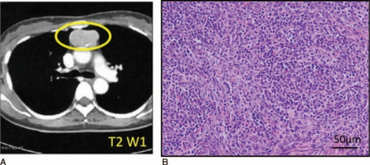Thymoma with immunodeficiency
Thymoma with immunodeficiency (also known as "Good syndrome") is a rare disorder that occurs in adults in whom hypogammaglobulinemia, deficient cell-mediated immunity, and thymoma (usually benign) may develop almost simultaneously.[1]: 82 [2] Most reported cases are in Europe, though it occurs globally.[3]
Dr. Robert Good was first to describe the association between thymoma and hypogammaglobulinemia in 1954.[4] Much remains to be understood about its pathogenesis.[5]
Signs and symptoms
Most patients present with an immunodeficient state and recurrent sinopulmonary infections in their 4th or 5th decade of life. The immunodeficiency may occur before or after the diagnosis of a thymoma.[4]
Immunodeficiency involves both deficient humoral and cellular immunity. Patients have low total serum antibodies. The thymoma may inhibit the thymus’s normal role in production of self-tolerant T lymphocytes. These T-lymphocytes then attack the B cell precursors in the marrow, preventing maturation and ultimately resulting in hypogammaglobulinemia.
Good Syndrome is associated with other autoimmune conditions including pure red cell aplasia[6] and myasthenia gravis.[4]
Pathogenesis
The cause of Good Syndrome is unknown. It is thought to be an autoimmune process affecting the bone marrow.[3]
Diagnosis
Definition
There are no formal diagnostic criteria.[5] Generally it can be defined as an adult-onset primary immunodeficiency associated with thymoma, hypogammaglobulinemia, diminished B and T cells, and inverted CD4/CD8+ ratio.[2] It has been suggested that Good Syndrome is a subset of common variable immunodeficiency (CVID).[3]
Treatment
The mainstay of treatment consists of thymectomy and immunoglobulin replacement with intravenous immunoglobulin. Immunodeficiency does not resolve after thymectomy. Immunosuppression is sometimes used.[2]
The Centers for Disease Control and Prevention recommend pneumococcal, meningococcal, and Hib vaccination in those with diminished humoral and cell-mediated immunity.
Some have advocated prophylaxis with trimethoprim-sulfamethoxazole if CD4 counts are lower than 200 cells/mm^3, similar to HIV/AIDS patients.
See also
References
- ↑ James, William D.; Berger, Timothy G.; et al. (2006). Andrews' Diseases of the Skin: Clinical Dermatology. Saunders Elsevier. ISBN 0-7216-2921-0.
- ↑ 2.0 2.1 2.2 Miyakis, Spiros; Pefanis, Angelos; et al. (2006). "Thymoma with immunodeficiency (Good's syndrome): Review of the literature apropos three cases". Scandinavian Journal of Infectious Diseases. 38 (4): 314–320. doi:10.1080/00365540500372663. PMID 16718939. S2CID 44472631.
- ↑ 3.0 3.1 3.2 Kelesidis, Theodoros; Otto, Yang (2010). "Good's syndrome remains a mystery after 55 years: A systematic review of the scientific evidence". Clinical Immunology. 135 (3): 347–363. doi:10.1016/j.clim.2010.01.006. PMC 8071094. PMID 20149753.
- ↑ 4.0 4.1 4.2 Kelleher, P; Misbah, S A (2003). "What is Good's syndrome? Immunological abnormalities in patients with thymoma". Journal of Clinical Pathology. 56 (1): 12–16. doi:10.1136/jcp.56.1.12. PMC 1769851. PMID 12499426.
- ↑ 5.0 5.1 Jansen, Anne; van Deuren, Marcel; et al. (2016). "Prognosis of Good syndrome: mortality and morbidity of thymoma associated immunodeficiency in perspective". Clinical Immunology. 171: 12–17. doi:10.1016/j.clim.2016.07.025. PMID 27497628. Archived from the original on 2022-03-25. Retrieved 2022-01-04.
- ↑ Hirokawa, Makoto; Sawada, Ken-ichi; et al. (January 2008). "Long-term response and outcome following immunosuppressive therapy in thymoma-associated pure red cell aplasia: a nationwide cohort study in Japan by the PRCA collaborative study group". Haematologica. 93 (1): 27–33. doi:10.3324/haematol.11655. PMID 18166782. Archived from the original on 2021-04-18. Retrieved 2022-01-04.
External links
| External resources |
|---|
